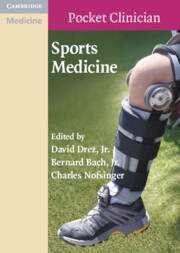Book contents
- Frontmatter
- Contents
- Preface
- Achilles Tendinitis to Axillary Vein Thrombosis
- Bipartite Patella to Brachial Plexus Injuries
- Calcaneal Stress Fractures to Cubital Tunnel Syndrome
- Digital Dislocations to Distal Quadriceps Tendinitis
- Elbow Dislocation to Exertional Hyponatremia
- Femoral Neck Stress Fractures to Frostbite
- Gamekeeper's Thumb (aka Skier's Thumb) to Groin Pain
- Hamstring Strain to Hypothermia
- Iliotibial Band Syndrome to Intersection Syndrome
- Knee Arthritis to Knee Dislocations and Combined Knee Ligament Injuries
- Labral Tears of the Hip to Lumbar Strain
- Mallet Finger to Myositis Ossificans
- Nailbed Injuries to Navicular Stress Fractures
- Olecranon Bursitis to Osteolysis of the Distal Clavicle
- Patellar Tendinitis to Proximal Humerus Fractures
- Quadriceps Contusions to Quadriceps Strains
- Radial Collateral Ligament Injury of the Thumb (Reverse Gamekeeper's) to Rotator Cuff Pathology
- Scaphoid Fractures to Syndesmosis Sprains
- Tennis Leg to Turf Toe Injury
- Ulnar Nerve Instability at the Elbow
- Volar Plate Injuries to Voluntary Shoulder Instability
- Wrist Ligament Injuries (Radial Side Injuries)
Preface
Published online by Cambridge University Press: 04 April 2011
- Frontmatter
- Contents
- Preface
- Achilles Tendinitis to Axillary Vein Thrombosis
- Bipartite Patella to Brachial Plexus Injuries
- Calcaneal Stress Fractures to Cubital Tunnel Syndrome
- Digital Dislocations to Distal Quadriceps Tendinitis
- Elbow Dislocation to Exertional Hyponatremia
- Femoral Neck Stress Fractures to Frostbite
- Gamekeeper's Thumb (aka Skier's Thumb) to Groin Pain
- Hamstring Strain to Hypothermia
- Iliotibial Band Syndrome to Intersection Syndrome
- Knee Arthritis to Knee Dislocations and Combined Knee Ligament Injuries
- Labral Tears of the Hip to Lumbar Strain
- Mallet Finger to Myositis Ossificans
- Nailbed Injuries to Navicular Stress Fractures
- Olecranon Bursitis to Osteolysis of the Distal Clavicle
- Patellar Tendinitis to Proximal Humerus Fractures
- Quadriceps Contusions to Quadriceps Strains
- Radial Collateral Ligament Injury of the Thumb (Reverse Gamekeeper's) to Rotator Cuff Pathology
- Scaphoid Fractures to Syndesmosis Sprains
- Tennis Leg to Turf Toe Injury
- Ulnar Nerve Instability at the Elbow
- Volar Plate Injuries to Voluntary Shoulder Instability
- Wrist Ligament Injuries (Radial Side Injuries)
Summary
A myriad of sports medicine textbooks have flooded the publishing marketplace in the past 20 years. Sports Medicine, and its first two iterations as Pocket Sports Medicine, was developed and marketed for the increasing demand of PDA users. The genesis of this concept evolved around the observation that many young physicians, residents, interns, and medical students need a quick way to access information “on the run.” Relevant sports medicine topics were determined, an outstanding faculty of contributing authors was recruited, and 150 sports medicine topics were identified. Pocket Sports Medicine was organized in a fashion that would allow the reader or “accessor” an opportunity to learn or review basic information on topics as varied as neck injuries in athletes, ACL injuries, LisFranc fracture-dislocations, groin injuries, and “Little Leaguer's elbow.” Although not designed to provide a comprehensive review, a single topic could be reviewed in less than 2 minutes. The consistent organizational structure follows a theme of 1) history, 2) physical examination, 3) imaging, 4) differential diagnosis, 5) treatment, and 6) pearls and pitfalls. Topics are organized in a bullet point outlined format. The editors believe that the printed format of the popular PDA derivative has a place in the lab coat pockets of residents, medical students, and ER physicians. When dealing with sports injuries, time management is at a premium. In the time that it takes to walk to the medical school library to read about hemarthrosis, you can read about the topic in Sports Medicine.
- Type
- Chapter
- Information
- Sports Medicine , pp. xi - xiiPublisher: Cambridge University PressPrint publication year: 2008

